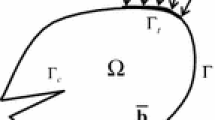Abstract
This paper presents a hybrid Trefftz (HT) boundary element method (BEM) by using two indirect techniques for mode III fracture problems. Two Trefftz complete functions of Laplace equation for normal elements and a special purpose Trefftz function for crack elements are proposed in deriving the Galerkin and the collocation techniques of HT BEM. Then two auxiliary functions are introduced to improve the accuracy of the displacement field near the crack tips, and stress intensity factor (SIF) is evaluated by local crack elements as well. Furthermore, numerical examples are given, including comparisons of the present results with the analytical solution and the other numerical methods, to demonstrate the efficiency for different boundary conditions and to illustrate the convergence influenced by several parameters. It shows that HT BEM by using the Galerkin and the collocation techniques is effective for mode III fracture problems.
Similar content being viewed by others
References
Trefftz, T.E.: Ein Gegenstück zum Ritzschen Verfahren. In: Proceedings 2nd International Congress of Applied mechanics, Zurich, pp. 131–137 (1926)
Huang S.C. and Shaw R.P. (1995). The Trefftz method as an internal equation. Adv. Eng. Softw. 24: 57–63
Mikhlin S.G. (1964). Variational Methods in Mathematical Physics. Pergamon Press, Oxford
Kupradze, V.D.: Three Dimensional Problems of the Mathematical Theory of Elasticity and Thermoelasticity. North Holland, Amsterdam (1979)
Piltner R. (1995). Rencent developments in the Trefftz method for finite element and boundary element applications. Adv. Eng. Softw. 24: 107–115
Zienkiewicz, O.C.: Trefftz type of approximation and the finite element method—history and development. In: First International Workshop on Trefftz Method—Recent Development and Perspectives. Cracow University of Technology, Poland, pp. 103 (1996)
Jirousek, J., Zielinski, A.P.: Survey of Trefftz-type element formulations. In: First International Workshop on Trefftz Method—Recent Development and Perspectives. Cracow University of Technology, Poland, pp. 103 (1996)
Qin Q.H. (2000) The Trefftz Finite and Boundary Element Method. WIT Press, Southampton
Jirousek, J., Venkatesh, A.: Hybrid-Trefftz plane elasticity elements with p-method capabilities. Int. J. Numer. Meth. Eng. 35, 1443–1472 (1992)
Piltner R. (1985). Special finite elements with holes and internal cracks. Int. J. Numer. Meth. Eng. 21: 1471–1485
Venkatesh A. and Jirousek J. (1995). Accurate representation of local effect due to concentrated and discontinuous loads in hybrid-Trefftz plate bending elements. Comput. Struct. 57: 863–870
Jirousek J. and Teodorescu P. (1982). Large finite elements method for the solution of problems in the theory of elasticity. Comput. Struct. 15: 575–587
Portela A., Aliabadi M.H. and Rooke D.P. (1992). The dual boundary element method: effective implementation for crack problems. Int. J. Numer. Methods Eng. 33: 1269–1287
Freitas J.A.T. and Ji Z.Y. (1996). Hybrid-Trefftz equilibrium model for crack problems. Int. J. Numer. Meth. Eng. 39: 569–584
Sabino J., Portela A. and Castro P.M.S.T. (1999). Trefftz boundary element method applied to fracture mechanics. Eng. Frac. Mech. 64: 67–86
Gray L.J. (1987). Boundary Element Method for Regions with Thin Interal Cavities. IBM Bergen, Norway
Cui Y.H. and Qin Q.H. (2006). Discussion on anti-plane crack problems by hybrid Trefftz finite element approach. Acta Mech. Solida Sinica, 27: 167–174
Cui Y.H., Qin Q.H. and Wang J.S. (2006). Application of HT finite element approach on mode I, II and III complex problems. Eng. Mech. 23: 104–110
Portela A. and Charafi A. (1997). Porgramming Trefftz boundary elements. Adv. Eng. Softw. 28: 509–523
Leitão V.M.A. (1998). Applications of multi-region Trefftz-collocation to fracture mechanics. Eng. Anal. Bound. Elem. 22: 251–256
Domingues J.S., Portela A. and Castro P.M.S.T. (1999). Trefftz boundary element method applied to fracture mechanics. Eng. Fract. Mech. 64: 67–86
Zielinski A.P. and Zienkiewicz O.C. (1985). Generalized finite element analysis with T-complete boundary solution functions. Int. J. Numer. Meth. Eng. 21: 509–528
Rooke D.P. and Cartwright D.S. (1976). Compendium of Stress Intensity Factors. HerMajestys Stationery Office, London
Isida M. (1970). Analysis of stress intensity factors for plates containing a random array of cracks. Bull JSME 13: 635–642
Sih C.G. (1973). Handbook of Stress Intensity Factors. HerMajestys Stationery Office, London
Silling, S.A.: Singularities and phase transitions in elastic solids: numerical studies and stability analysis. (Ph. D. thesis), California Institute of Technology (1986)
Horgan C.O. and Silling S.A. (1987). Stress concentration factors in finite anti-plane shear numerical calculations and analytical estimates. J. Elast. 18: 83–91
Zhang X.S. (1988). Thegeneral solution of an edge crack off the center line of a rectangular sheet for Mode III. Eng. Fract. Mech. 31: 847–855
Sun Y.Z., Yang S.S. and Wang Y.B. (2003). A new formulation of boundary element method for cracked anisotropic bodies under anti-plane shear. Comput. Methods Appl. Mech. Eng. 192: 2633–2648
Author information
Authors and Affiliations
Corresponding author
Additional information
The project supported by the National Natural Science Foundation of China(10472082). The English text was polished by Keren Wang.
Rights and permissions
About this article
Cite this article
Cui, Y., Wang, J., Dhanasekar, M. et al. Mode III fracture analysis by Trefftz boundary element method. Acta Mech Sin 23, 173–181 (2007). https://doi.org/10.1007/s10409-007-0056-7
Received:
Revised:
Accepted:
Published:
Issue Date:
DOI: https://doi.org/10.1007/s10409-007-0056-7




